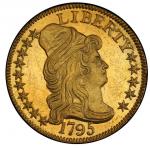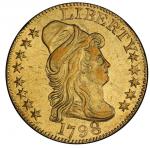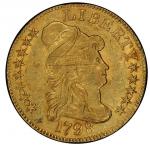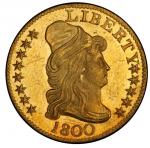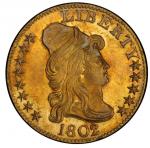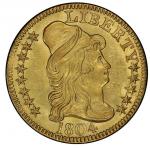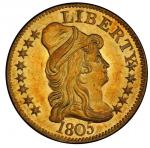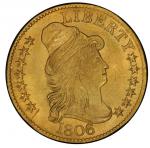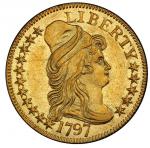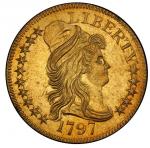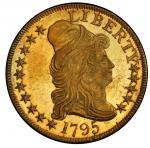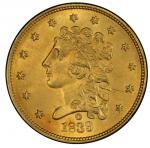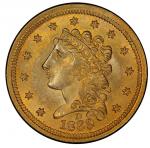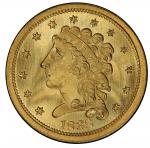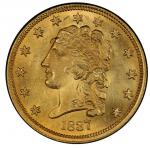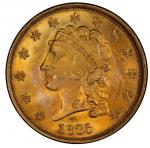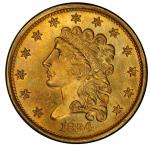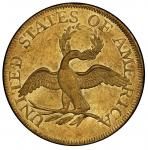1798 Capped Bust Right Half Eagle. Bass Dannreuther-1. Rarity-7. Small Eagle. AU-55 (PCGS).
"Paul Wittlin got a real buy, lot 229 for $1,800. The five pieces included a 1798 half eagle, Small Eagle reverse variety -- an extremely rare item." -- Abe Kosoff,
"Farouk’s Gold Parades," Coin World, November 2, 1977
Like Martha the passenger pigeon, the 1798 Small Eagle half eagle was the last of its species, a lone final die marriage to use the anachronistic first reverse type struck after the introduction of its Heraldic Eagle replacement in 1797. It is one of the great rarities in the entire series of American coins, perhaps somewhat overlooked precisely because it is so rare. Just six examples are known, of which only three remain outside of institutions and able to be collected.
Bright reflective luster dominates the fields on both sides, undimmed at the peripheries and around devices. The incongruity of a 1798-dated obverse, or any obverse with 13 stars, matched with this ancient reverse makes for an enjoyable in-hand examination. The usual array of fine marks and minor hairlines show up against their reflective backdrop, none of gross seriousness. A horizontal mark on Liberty's cheek is noted parallel to the base of the ear curl, noted alongside a mark in the field left of star 4 and some light chatter left of the reverse wreath. The reverse rim at the top of that side is trivially rounded, perhaps natural or perhaps a minor abrasion. A natural pit or depression abuts the left side of star 1. Parallel vestiges of adjustment are evident but not distracting in the left obverse field.
Magnified scrutiny rewards the technically minded numismatist, who will find the unusual arc die crack beneath the date, likely following the path of an overzealously inscribed guide line intended to help locate the denticles and other design elements, extending to outside of stars 1 through 4 at one end and beyond the 8 on the other. A similar artifact of the inartfully accomplished inner circle is visible above RTY of LIBERTY. Examination of the reverse will find heavily lapping manifesting as design elements that are half missing, including a leaf atop the wreath on the left side, a leaf on the olive branch, and the upper right serif of I in AMERICA. This state, common to all known examples, is called Bass-Dannreuther reverse state c.
Few half eagles can surpass the 1798 Small Eagle in terms of its pure rarity. The 1815 half eagle cannot, legendary though it may be. Nor can any other major variety of the Draped Bust half eagle series, save the unique 1797 Large Eagle, forever impounded in the Smithsonian Institution and not widely known except to specialists. It is only appropriate that the only private collection anywhere that includes the 1822 and 1854-S half eagles, the crown jewels of the denomination, would also include the finest known specimen of the 1798 Small Eagle. Three examples of this great rarity are impounded: the American Numismatic Association houses the Clapp-Eliasberg coin in the Harry Bass Core Collection, and the Smithsonian Institution holds both the Parmelee coin from the Mint Cabinet and the Ten Eyck-Col. E.H.R. Green-J.K. Lilly coin. That leaves an equal number of specimens of this extraordinary rarity, just three coins, remaining in private hands. Only two have been certified by PCGS, of which this is by far the finer. The Earle-Atwater coin, said to be untraced since 1946, is actually the piece rediscovered by John Dannreuther in 1996 and sold by Ira and Larry Goldberg in 2000. The Atwater plate is of little use, but the Earle plate is crystal clear, clear enough to tell with certainty that the reverse is that of the Dannreuther coin and the image labeled as the obverse is actually the obverse of the following lot, which happened to be struck from the same die. The reverse identification is enough, however, to marry these two broken provenance chains.
The 1798 Small Eagle half eagle once held the record for the most valuable American coin, and perhaps the most valuable coin of any origin, ever sold. When the Earle specimen realized $3000 in June 1912, it made national headlines. The June 29, 1912, issue of The Sun in New York City trumpeted "$3,000 FOR A 1798 HALF EAGLE" on page 1, calling it "the gem of the collection gathered by George H. Earle, Jr." The article also singled out the silver 1776 Continental dollar that sold in the same session for $2,200. Small town newspapers across Pennsylvania featured the story, along with dailies as diverse as the Washington Herald in Washington D.C. and the Seymour Daily Republican of Seymour, Indiana.
When this coin was offered in the 1955 Farish Baldenhofer sale, it was the only coin depicted on the catalog cover. Selling for $6,000, it brought nearly six times the price of an 1827 quarter ($1,050), twice as much as an 1838-O half dollar ($3,200), and more than three times as much as a prooflike Mint State 1797 half dollar ($1,750). An 1815 half eagle brought $3,000, while a Proof 1804 Plain 4 eagle brought $2,500. The entire auction yielded not quite $110,000, and this coin was the runaway star.
In recent years, few specimens of this variety have sold. Many experienced collectors and dealers have never seen one, and likely more than a few don’t even know such a coin exists. Since this example sold in 1955, the last time it was offered at public auction, this type has been sold just three times. The Garrett coin sold in 1979 after having been off the market since 1883. The Clapp-Eliasberg specimen sold in 1982; it was that coin's only auction appearance. The Atwater example sold in 2000, having failed to sell in an auction a year earlier after being considered lost for more than a half century. These appearances amount to just four opportunities to acquire a specimen in the last 60 years, two of which were owed solely to the serendipitous appearance of a multigenerational old-time collection at auction. No 1798 Small Eagle half eagle has been offered in the last 15 years.
While even connoisseurs can rarely be finicky with a rarity such as this, the quality of this example is unmatched. No other 1798 Small Eagle $5, in public or private hands, surpasses this one. It exceeds the only other PCGS-certified specimen by 15 points. The provenance is similarly august, though regal may be the better term, having been in the collection of King Farouk of Egypt. Farouk purchased this coin from Stack's, and his collection was sold by Sotheby's. In some ways, this appearance has brought it full circle. For decades, this coin was included in the collection of Texan John H. Murrell, the owner of what Doug Winter has called "the greatest unknown collection of U.S. gold coins ever assembled." Now offered from the most valuable collection of American coins ever formed, this great American rarity is set to find a new and similarly impressive home.
PCGS# 8071. NGC ID: 25NJ.
Publications: The Numismatist, April 1935, May 1935, and June 1935. Breen, Walter. Early United States Half Eagles 1795-1838, 1966, pp. 13-14. Akers, David. United States Gold Coins: An Analysis of Auction Records, Volume IV, Half Eagles 1795-1829, 1979, p. 7. Breen, Walter. Walter Breen's Complete Encyclopedia of United States and Colonial Coins, 1988, pp. 512-513. Bowers, Q. David. The American Numismatic Association Centennial History, 1991, Volume 1, p. 515, 517, and 529. Dannreuther, John. "The Ultra Rare 1798 Small Eagle Reverse Half Eagle." PCGS Market Report, August 15, 2000.
Provenance: Raymond Caldwell of Lancaster, Pennsylvania; Col. James W. Flanagan Collection, after 1935; Stack's sale of the Col. James W. Flanagan Collection, March 1944, lot 1063; Clifford T. Weihman Collection; Stack's, by sale, after 1946; King Farouk of Egypt Collection; Sotheby & Co.'s sale of the Palace Collections of Egypt, February 1954, lot 229, via Paul Wittlin; William G. Baldenhofer Collection; Stack's sale of the Farish Baldenhofer Collection, January 1955, lot 1203 (at $6,000);
John H. Murrell Collection; Goliad Corporation (Mike Brownlee), by sale, August 1979.

